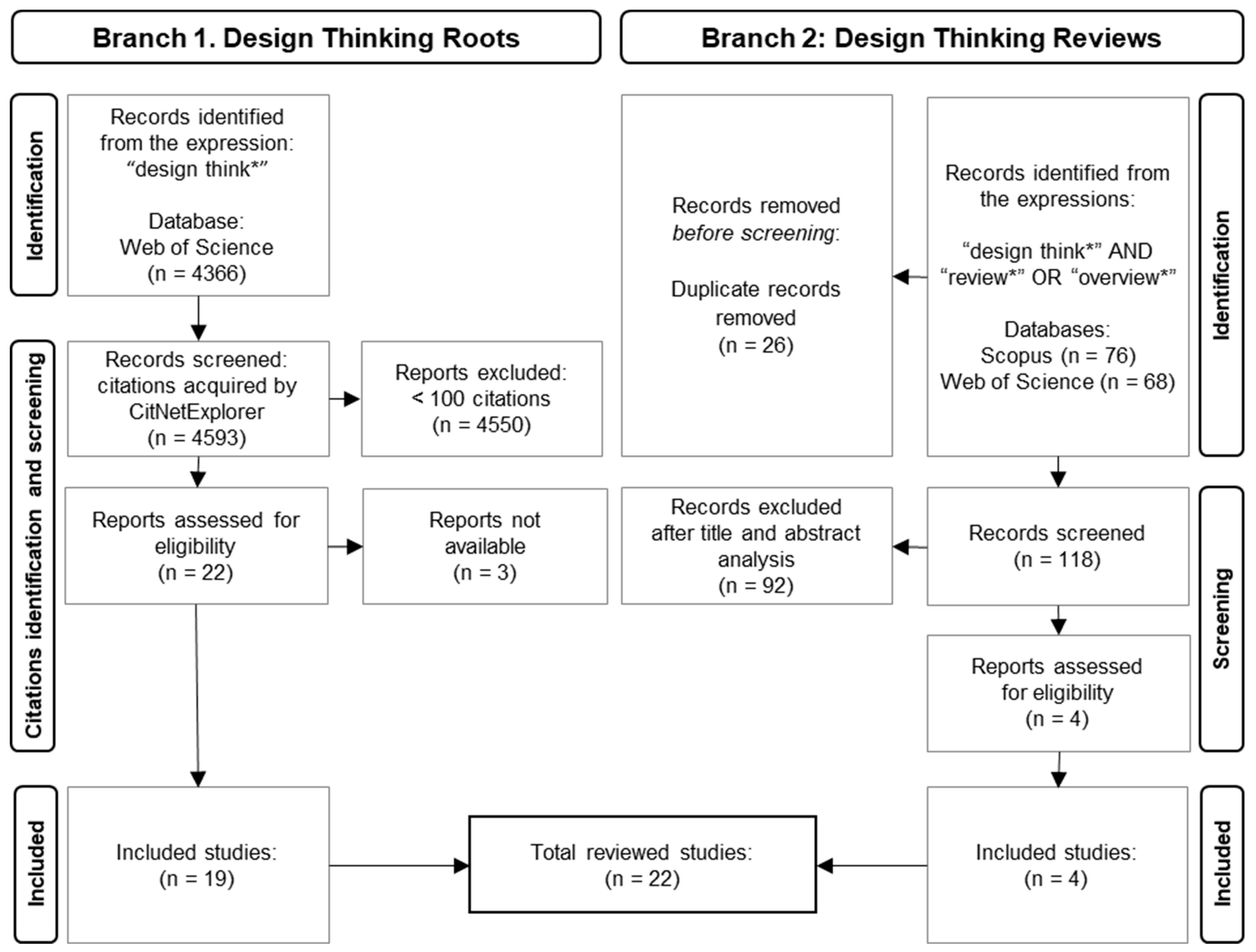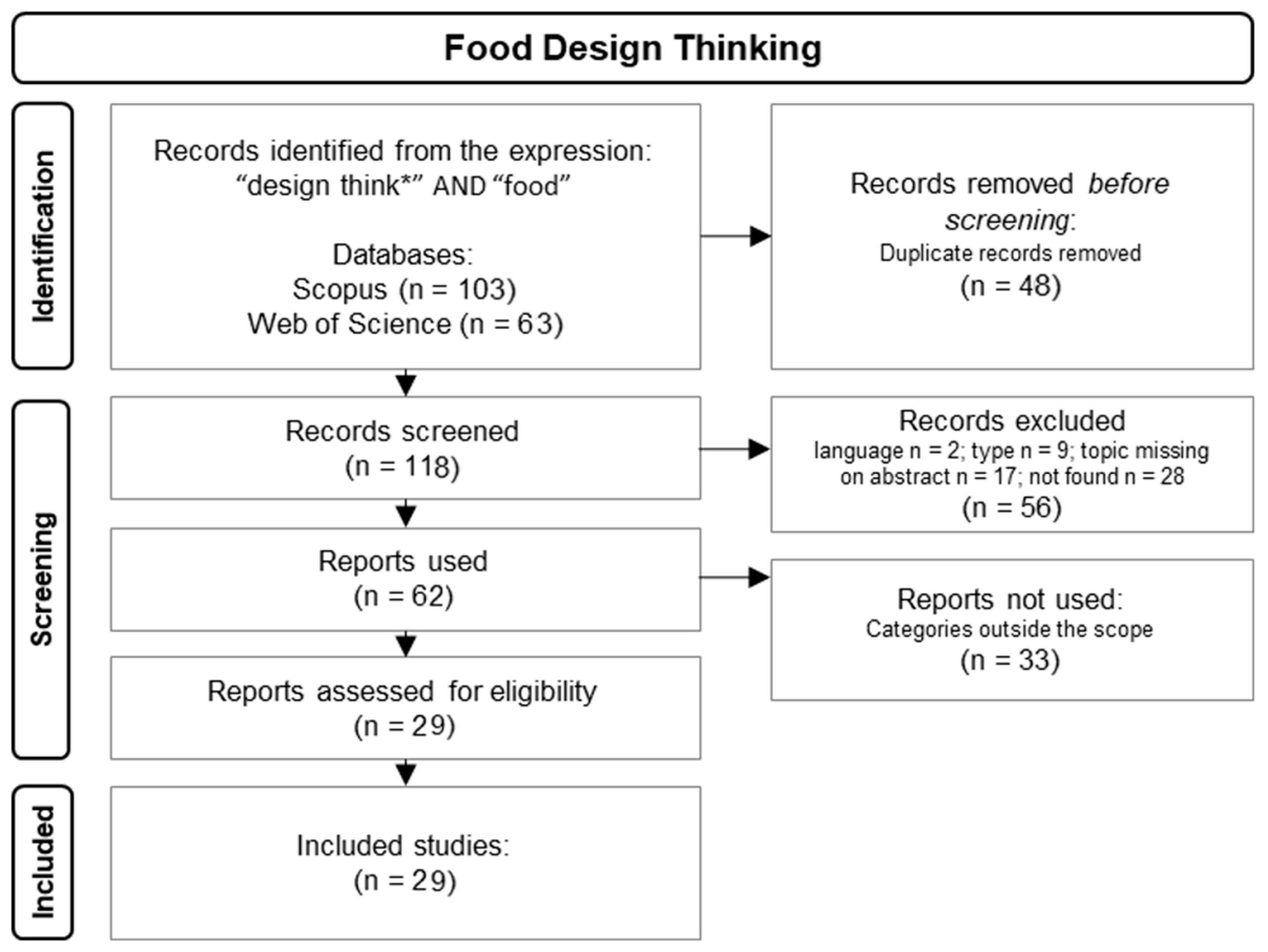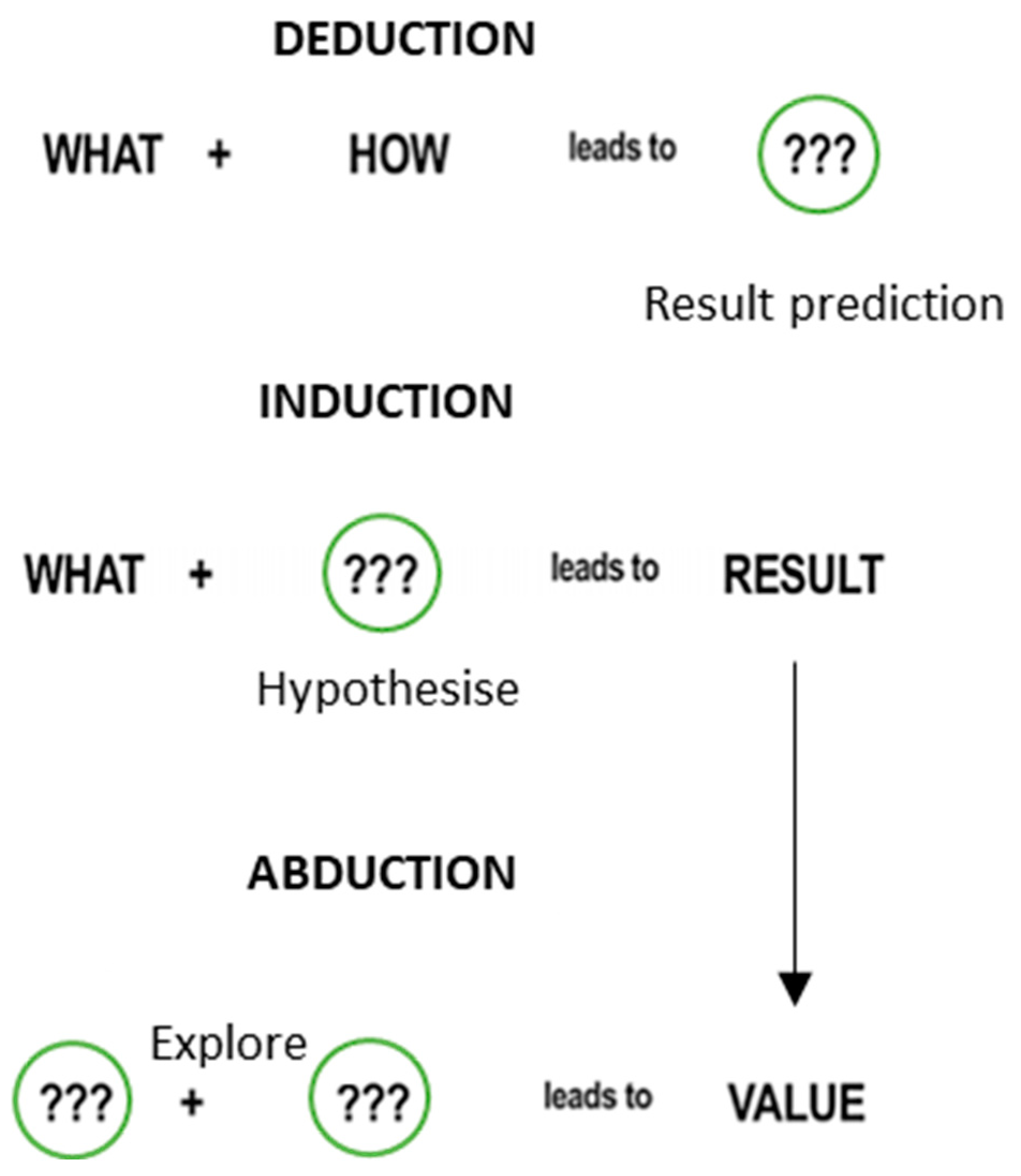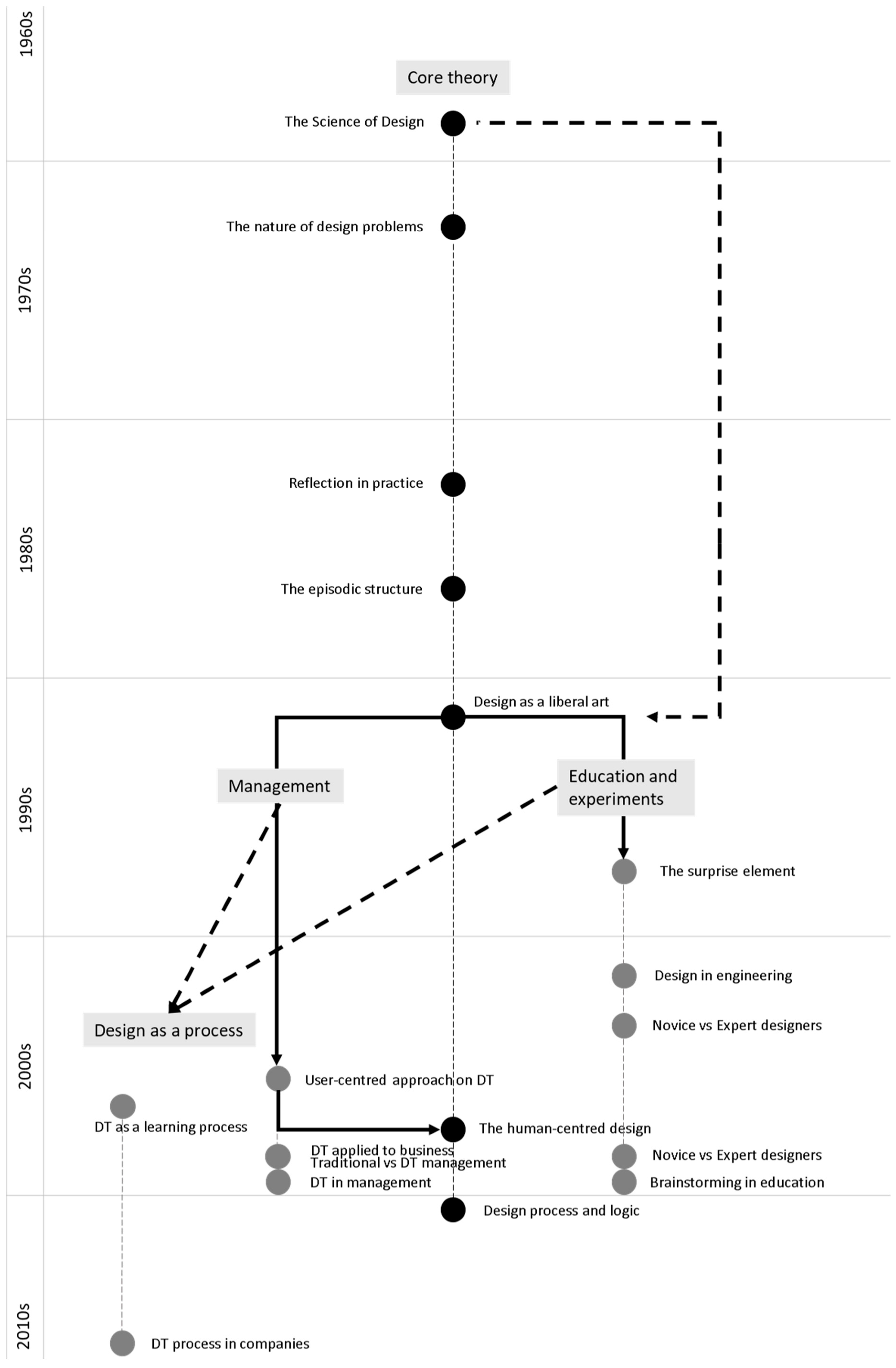Food Design Thinking: A Systematic Review from an Evolutionary Perspective
Abstract
:1. Introduction
2. Methodology
3. Results and Discussion
3.1. Methodological Notes
3.2. Part 1. The Roots of Design Thinking
3.2.1. Design Thinking
3.2.2. Design Thinking as a Liberal Art
3.2.3. Human-Centred Design
3.2.4. Design Thinking as a Process
3.2.5. Design Thinking Reviews
3.3. Main Remarks on the Evolution of the Concept of Design Thinking
3.4. Part 2. Design Thinking in Food Studies
3.4.1. Theory and Models of Food Design Thinking
3.4.2. Food Design Thinking and Education
3.4.3. Designing for Sustainability
3.4.4. Design Thinking for Health and Wellbeing
3.4.5. Design Thinking for the Development of Food Products
3.5. Main Remarks on the Concept of Food Design Thinking
4. Conclusions
Author Contributions
Funding
Institutional Review Board Statement
Informed Consent Statement
Data Availability Statement
Conflicts of Interest
References
- Costa, A.; Jongen, W. New insights into consumer-led food product development. Trends Food Sci. Technol. 2006, 17, 457–465. [Google Scholar] [CrossRef]
- Olsen, N. Design Thinking and food innovation. Trends Food Sci. Technol. 2015, 41, 182–187. [Google Scholar] [CrossRef]
- Johansson-Skoldberg, U.; Woodilla, J.; Cetinkaya, M. Design Thinking: Past, Present and Possible Futures. Creat. Innov. Manag. 2013, 22, 121–146. [Google Scholar] [CrossRef]
- Micheli, P.; Wilner, S.; Bhatti, S.; Mura, M.; Beverland, M. Doing Design Thinking: Conceptual Review, Synthesis, and Research Agenda. J. Prod. Innov. Manag. 2019, 36, 124–148. [Google Scholar] [CrossRef]
- Carlgren, L.; Elmquist, M.; Rauth, I. Design Thinking: Exploring Values and Effects from an Innovation Capability Perspective. Des. J. 2015, 17, 403–423. [Google Scholar] [CrossRef]
- Brown, T. Design thinking. Harv. Bus. Rev. 2008, 86, 84. [Google Scholar] [PubMed]
- Dunne, D.; Martin, R. Design thinking and how it will change management education: An interview and discussion. Acad. Manag. Learn. Educ. 2006, 5, 512–523. [Google Scholar] [CrossRef]
- Buchanan, R. Wicked Problems in Design Thinking. Des. Issues 1992, 8, 5–21. [Google Scholar] [CrossRef]
- Cross, N. Designerly ways of knowing: Design discipline versus design science (The 1920s and the 1960s, two important periods in the modern history of design). Des. Issues 1982, 17, 49–55. [Google Scholar] [CrossRef]
- Lawson, B. How Designers Think; Routledge: London, UK, 2006. [Google Scholar]
- Simon, H. The Sciences of the Artificial; The MIT Press: Cambridge, MA, USA, 1969. [Google Scholar]
- Kimbell, L. Rethinking Design Thinking: Part I. Des. Cult. 2011, 3, 285–306. [Google Scholar] [CrossRef]
- Alexander, C. Notes on the Synthesis of Form; Harvard University Press: Cambridge, MA, USA, 1964; Volume 5. [Google Scholar]
- Cross, N. Design Thinking: Understanding How Designers Think and Work; Berg: Oxford, UK, 2011. [Google Scholar]
- McCausland, T. Design Thinking Revisited. Res. Technol. Manag. 2020, 63, 59–63. [Google Scholar] [CrossRef]
- Jen, N. Design Thinking Is Bullsh*t. In Proceedings of the Adobe 99U Conference, New York, NY, USA, 7–9 June 2017. [Google Scholar]
- Miller, D.; Hartwick, J.; Le Breton-Miller, I. How to detect a management fad—And distinguish it from a classic. Bus. Horiz. 2004, 47, 7–16. [Google Scholar] [CrossRef]
- Martins, R. Is Design Thinking sinking? Eight evidences that prove it is a fad. In Ricardo Martins Insights (Blog), 2 December 2020. Available online: https://ideiasricardomartins.wordpress.com/2020/12/02/eight-evidences-that-prove-design-thinking-is-a-fad/ (accessed on 28 July 2024).
- Nussbaum, B. Design Thinking Is A Failed Experiment. So What’s Next? FastCompany 5 July 2021. Available online: https://www.fastcompany.com/1663558/design-thinking-is-a-failed-experiment-so-whats-next (accessed on 28 July 2024).
- Schwab, K. Ideo Breaks Its Silence on Design Thinking’s Critics. FastCompany 5 July 2021. Available online: https://www.fastcompany.com/90257718/ideo-breaks-its-silence-on-design-thinkings-critics (accessed on 28 July 2024).
- Shimek, L. Design Thinking for Food: An Overview and Potential Application for Grains. Cereal Foods World 2018, 63, 245–248. [Google Scholar] [CrossRef]
- Liedtka, J. Perspective: Linking Design Thinking with Innovation Outcomes through Cognitive Bias Reduction. J. Prod. Innov. Manag. 2015, 32, 925–938. [Google Scholar] [CrossRef]
- Page, M.; McKenzie, J.; Bossuyt, P.; Boutron, I.; Hoffmann, T.; Mulrow, C.; Shamseer, L.; Tetzlaff, J.; Akl, E.; Brennan, S. The PRISMA 2020 statement: An updated guideline for reporting systematic reviews. BMJ 2020, 372, n71. [Google Scholar] [CrossRef]
- Rittel, H.; Webber, M. Dilemmas in a general theory of planning. Policy Sci. 1973, 4, 155–169. [Google Scholar] [CrossRef]
- Schön, D. The Reflective Practitioner: How Professionals Think in Action; Routledge: London, UK, 1983. [Google Scholar]
- Rowe, P. Design Thinking; MIT Press: Cambridge, MA, USA, 1987. [Google Scholar]
- Dorst, K. The core of ‘design thinking’ and its application. Design Stud. 2011, 32, 521–532. [Google Scholar] [CrossRef]
- Dorst, K.; Cross, N. Creativity in the design process: Co-evolution of problem–solution. Design Stud. 2001, 22, 425–437. [Google Scholar] [CrossRef]
- Dym, C.; Agogino, A.; Eris, O.; Frey, D.; Leifer, L. Engineering design thinking, teaching, and learning. J. Eng. Educ. 2005, 94, 103–120. [Google Scholar] [CrossRef]
- Cross, N. Creative thinking in design: An introduction. In Proceedings of the 2007 Symposium on Science of Design, Arcata, CA, USA, 22 March 2007; pp. 2–3. [Google Scholar]
- Razzouk, R.; Shute, V. What Is Design Thinking and Why Is It Important? Rev. Educ. Res. 2012, 82, 330–348. [Google Scholar] [CrossRef]
- Seidel, V.; Fixson, S. Adopting Design Thinking in Novice Multidisciplinary Teams: The Application and Limits of Design Methods and Reflexive Practices. J. Prod. Innov. Manag. 2013, 30, 19–33. [Google Scholar] [CrossRef]
- Brown, T. Change by Design: How Design Thinking Transforms Organizations and Inspires Innovation; HarperCollins: New York, NY, USA, 2009. [Google Scholar]
- Martin, R. The Design of Business: Why Design Thinking Is the Next Competitive Advantage; Harvard Business Press: Cambridge, MA, USA, 2009. [Google Scholar]
- Brown, T.; Wyatt, J. Design thinking for social innovation. Dev. Outreach 2010, 12, 29–43. [Google Scholar] [CrossRef]
- Beckman, S.; Barry, M. Innovation as a learning process: Embedding design thinking. Calif. Manag. Rev. 2007, 50, 25–56. [Google Scholar] [CrossRef]
- Carlgren, L.; Rauth, I.; Elmquist, M. Framing Design Thinking: The Concept in Idea and Enactment. Creat. Innov. Manag. 2016, 25, 38–57. [Google Scholar] [CrossRef]
- Waidelich, L.; Richter, A.; Kolmel, B.; Bulander, R. Design Thinking Process Model Review A systematic literature review of current Design Thinking models in practice. In Proceedings of the IEEE International Conference on Engineering, Technology and Innovation (ICE/ITMC), Stuttgart, Germany, 17–20 June 2018. [Google Scholar]
- You, X.; Hands, D. A Reflection upon Herbert Simon’s Vision of Design in The Sciences of the Artificial. Des. J. 2019, 22, 1345–1356. [Google Scholar] [CrossRef]
- Michalos, A. The Sciences of the Artificial by Herbert A. Simon (Book Review). Technol. Cult. 1970, 11, 118–120. [Google Scholar]
- Huppatz, D. Revisiting Herbert Simon’s “Science of Design”. Des. Issues 2015, 31, 29–40. [Google Scholar] [CrossRef]
- Rubin, M. Design Thinking. J. Archit. Educ. 1990, 43, 45–47. [Google Scholar] [CrossRef]
- New Catholic Encyclopedia; Analysis and Synthesis; Gale: Farmington Hills, MI, USA, 2019.
- Fann, K. Peirce’s Theory of Abduction; Springer Science & Business Media: New York, NY, USA, 2012. [Google Scholar]
- Guilford, J. The Nature of Human Intelligence; McGraw-Hill: New York, NY, USA, 1967. [Google Scholar]
- Owen, C. Design research: Building the knowledge base. Des. Stud. 1998, 19, 9–20. [Google Scholar] [CrossRef]
- Kolb, D. Experiential Learning: Experience as the Source of Learning and Development; Pearson Education: Hong Kong, China, 1984; Volume 1. [Google Scholar]
- Kelley, T.; Littman, J. The Ten Faces of Innovation: IDEO’s Strategies for Beating the Devil’s Advocate & Driving Creativity throughout Your Organization; Currency/Doubleday: New York, NY, USA, 2005. [Google Scholar]
- Zampollo, F.; Peacock, M. Food Design Thinking: A Branch of Design Thinking Specific to Food Design. J. Creat. Behav. 2016, 50, 203–210. [Google Scholar] [CrossRef]
- Franchini, G.; Dosi, C.; Vignoli, M. The coexistence of design thinking and stage and gate in the same organisational context-Challenges and need for integration. In Proceedings of the ICED17 21st International Conference on Engineering Design, Vancouver, BC, Canada, 21–25 August 2017; pp. 387–396. [Google Scholar]
- Sijtsema, S.; Fogliano, V.; Hageman, M. Tool to Support Citizen Participation and Multidisciplinarity in Food Innovation: Circular Food Design. Front. Sustain. Food Syst. 2020, 4, 582193. [Google Scholar] [CrossRef]
- Batat, W.; Addis, M. Designing food experiences for well-being: A framework advancing design thinking research from a customer experience perspective. Eur. J. Mark. 2021, 55, 2392–2413. [Google Scholar] [CrossRef]
- Massari, S.; Principato, L.; Antonelli, M.; Pratesi, C.A. Learning from and designing after pandemics. CEASE: A design thinking approach to maintaining food consumer behaviour and achieving zero waste. Socio-Econ. Plann. Sci. 2022, 82, 101143. [Google Scholar] [CrossRef]
- Mitchell, R.; Woodhouse, A.; Heptinstall, T.; Camp, J. Why use design methodology in culinary arts education? Hosp. Soc. 2013, 3, 239–260. [Google Scholar] [CrossRef]
- Frost, M. How to create a frame for collaboration between chefs and scientists-Business as unusual at Nordic Food Lab. Int. J. Gastron. Food Sci. 2019, 16, 100132. [Google Scholar] [CrossRef]
- Derler, H.; Berner, S.; Grach, D.; Posch, A.; Seebacher, U. Project-Based Learning in a Transinstitutional Research Setting: Case Study on the Development of Sustainable Food Products. Sustainability 2020, 12, 233. [Google Scholar] [CrossRef]
- Kaygan, P. From forming to performing: Team development for enhancing interdisciplinary collaboration between design and engineering students using design thinking. Int. J. Technol. Des. Educ. 2023, 33, 457–478. [Google Scholar] [CrossRef]
- Pärli, R.; Stauffacher, M.; Seigo, S.; Probst, M.; Pearce, B. Designing interventions for sustainable change in a real-world laboratory. Environ. Dev. Sustain. 2022, 1–15. [Google Scholar] [CrossRef]
- Nguyen, V.; Nguyen, T.; Huynh, T.; Nguyen, V.; Stigberg, S. Interactive Fridge: A Solution for Preventing Domestic Food Waste. In Proceedings of the 13th International Conference on Smart Homes and Health Telematics (ICOST), Geneva, Switzerland, 10–12 June 2015; pp. 361–366. [Google Scholar]
- Bonaccorsi, M.; Betti, S.; Rateni, G.; Esposito, D.; Brischetto, A.; Marseglia, M.; Dario, P.; Cavallo, F. ‘HighChest’: An Augmented Freezer Designed for Smart Food Management and Promotion of Eco-Efficient Behaviour. Sensors 2017, 17, 1357. [Google Scholar] [CrossRef]
- Kamil, M.; Hua, C.; Sani, M. Adaptation of smart-object dimensions in the product design process to reduce household food waste. J. Graph. Eng. Des. 2022, 13, 5–17. [Google Scholar] [CrossRef]
- Purnomo, D.; Bunyamin, A.; Nawawi, M.; Danuwidjadja, T.; Izzatulloh, M. Innovative post-harvested processing activation program for potential local agro-based food commodity using design thinking approach (Case Study: Keladi Tuber (Caladium bicolor Vent.) commodity in Manokwari, West Papua). In Proceedings of the 1st International Conference on Food and Bio-Industry (ICFB), Bandung, Indonesia, 29–30 July 2019. [Google Scholar]
- Adebayo, S.; Emuoyibofarhe, O.; Awofolaju, T. Cost efficient internet of things based smart farm system for rural farmers: Leveraging design thinking approach. Herit. Sustain. Dev. 2021, 3, 111–120. [Google Scholar] [CrossRef]
- Asawadechsakdi, W.; Chavalkul, Y. The Creation of Single-Use Packaging from Leaves to Reduce Plastic Waste in Thailand. J. Urban Cult. Res. 2021, 23, 273–286. [Google Scholar]
- Mummah, S.; King, A.; Gardner, C.; Sutton, S. Iterative development of Vegethon: A theory-based mobile app intervention to increase vegetable consumption. Int. J. Behav. Nutr. Phys. Act. 2016, 13, 1–12. [Google Scholar] [CrossRef] [PubMed]
- Bogomolova, S.; Carins, J.; Dietrich, T.; Bogomolov, T.; Dollman, J. Encouraging healthier choices in supermarkets: A co-design approach. Eur. J. Mark. 2020, 55, 2439–2463. [Google Scholar] [CrossRef]
- Fernhaber, S.; Wada, T.; Napier, P.; Suttles, S. Engaging diverse community stakeholders to co-create solutions in food deserts: A design-thinking approach. J. Public Aff. 2019, 19, e1874. [Google Scholar] [CrossRef]
- Kalita, P.; Das, S.; Das, A. Design Intervention for Livelihood and Hygiene for Street Vending of Panipuri. In Proceedings of the 6th International Conference on Research into Design (ICoRD), Guwahati, India, 9–11 January 2017; pp. 91–104. [Google Scholar]
- Rejikumar, G.; Aswathy, A.; Jose, A.; Sonia, M. A collaborative application of design thinking and Taguchi approach in restaurant service design for food wellbeing. J. Serv. Theory Pract. 2022, 32, 199–231. [Google Scholar] [CrossRef]
- Bunyamin, A.; Purnomo, D.; Taofik, S.; Chuddin, M.; Sawitri, I. Innovation on food product development for local commodity with design thinking approach (Case study: Tengkawang fruit (Shorea stenoptera Burck.) Commodity in Bengkayang, West Kalimantan). In Proceedings of the 1st International Conference on Food and Bio-Industry 2019, Bandung, Indonesia, 29–30 July 2019. [Google Scholar]
- Hastie, M.; Ashman, H.; Lyman, D.; Lockstone-Binney, L.; Jacob, R.; Ha, M.; Torrico, D.; Warner, R. Product Design to Enhance Consumer Liking of Cull Ewe Meat. Foods 2021, 10, 96. [Google Scholar] [CrossRef] [PubMed]
- Tkaczewska, J.; Kulawik, P.; Morawska-Tota, M.; Zajac, M.; Guzik, P.; Tota, L.; Pajak, P.; Dulinski, R.; Florkiewicz, A.; Migdal, W. Protocol for Designing New Functional Food with the Addition of Food Industry By-Products, Using Design Thinking Techniques-A Case Study of a Snack with Antioxidant Properties for Physically Active People. Foods 2021, 10, 694. [Google Scholar] [CrossRef] [PubMed]
- Gallen, C.; Pantin-Sohier, G.; Oliveira, D. How can the design thinking process improve an innovative insect-based food experience? Int. J. Food Des. 2022, 7, 29–58. [Google Scholar] [CrossRef]
- Castanho, A.; Guerra, M.; Brites, C.; Oliveira, J.C.; Cunha, L.M. Design thinking for food: Remote association as a creative tool in the context of the ideation of new rice-based meals. Int. J. Gastron. Food Sci. 2024, 31, 100664. [Google Scholar] [CrossRef]
- Castanho, A.; Brites, C.; Rocha, C.; Moura, A.P.; Oliveira, J.C.; Cunha, L.M. Adaptation of the Food Choice Questionnaire using a Design Thinking approach and application to rice consumption by the major European consumers. Food Qual. Prefer. 2023, 110, 104951. [Google Scholar] [CrossRef]
- Design Council. History of the Double Diamond. Available online: https://www.designcouncil.org.uk/our-resources/the-double-diamond/history-of-the-double-diamond/ (accessed on 28 July 2024).
- Hasso Plattner Institute. What Is Design Thinking? Available online: https://hpi-academy.de/en/design-thinking/what-is-design-thinking/ (accessed on 28 July 2024).
- Stanford University. An Introduction to Design Thinking-Process Guide. Available online: https://web.stanford.edu/~mshanks/MichaelShanks/files/509554.pdf (accessed on 28 July 2024).
- Cooper, R.; Kleinschmidt, E. Screening new products for potential winners. Long Range Plan. 1993, 26, 74–81. [Google Scholar] [CrossRef]
- Cunha, L.M.; Cabral, D.; Moura, A.P.; de Almeida, M.D.V. Application of the Food Choice Questionnaire across cultures: Systematic review of cross-cultural and single country studies. Food Qual. Prefer. 2018, 64, 21–36. [Google Scholar] [CrossRef]




| Author [Reference] | Publication Date | Citation Count | Main Contribution |
|---|---|---|---|
| Design Thinking | |||
| Simon [11] | 1969 | 195 | The science of design |
| Rittel and Webber [24] | 1973 | 192 | The nature of design problems |
| Schön [25] | 1983 | 199 | Reflection in practice |
| Rowe [26] | 1987 | 164 | The episodic structure |
| Buchanan [8] | 1992 | 312 | Design as a liberal art |
| Brown [6] | 2008 | 582 | Human-centred design |
| Dorst [27] | 2011 | 280 | Design process and logic |
| Education and experiments | |||
| Dorst and Cross [28] | 2001 | 146 | The surprise element |
| Dym et al. [29] | 2005 | 228 | Design in engineering education |
| Cross [30] | 2007 | 152 | Novice vs. expert designers |
| Razzouk and Shute [31] | 2012 | 179 | Novice vs. expert designers |
| Seidel and Fixson [32] | 2013 | 112 | Brainstorming in education |
| Design thinking and management | |||
| Dunne and Martin [7] | 2006 | 190 | User-centred approach to DT |
| Brown [33] | 2009 | 307 | DT applied to business |
| Martin [34] | 2009 | 228 | Traditional/DT-based companies |
| Brown and Wyatt [35] | 2010 | 173 | DT in management |
| Design as a process | |||
| Beckman and Barry [36] | 2007 | 144 | DT as a learning process |
| Carlgren et al. [37] | 2016 | 117 | The DT process in companies |
| Reviews | |||
| Liedtka [22] | 2015 | Biases on DT | |
| Kimbell [12] | 2011 | The three types of DT | |
| Micheli et al. [4] | 2019 | Defining DT | |
| Waidelich et al. [38] | 2018 | The DT processes | |
| Main Contributions/Objectives | DT Method | |
|---|---|---|
| Theory and models | ||
| Olsen [2] | Integrating the consumers from the beginning | N.a. |
| Zampollo and Peacock [49] | Describing the concept of FDT and generating new tools | N.a. |
| Franchini et al. [50] | Using stage-gate and FDT simultaneously | N.a. |
| Shimek [21] | Characterising FDT for product development | N.a. |
| Sijtsema et al. [51] | Designing a non-linear FDT model directed to sustainability | Double diamond |
| Batat and Addis [52] | Designing an FDT model to improve the food experience | Own model |
| Massari et al. [53] | Designing an FDT model directed at preventing food waste | Stanford d.School |
| Food Design Thinking and education | ||
| Mitchell et al. [54] | Implementing FDT | Double diamond |
| Frost [55] | Integrating science and culinary arts | N.a |
| Derler et al. [56] | Comparing FDT with traditional food development | 3I/IDEO |
| Kaygan [57] | Integrating industrial design with food engineering | Stanford d.School |
| Pärli et al. [58] | Shifting food practices towards sustainability | Own model |
| Designing for sustainability | ||
| Nguyen et al. [59] | Developing an interactive fridge to prevent food waste | HPI |
| Bonaccorsi et al. [60] | Developing a smart freezer | 3I/IDEO |
| Kamil et al. [61] | Developing a technological system to prevent food waste | Own model |
| Purnomo et al. [62] | Solving the problem of excess taro production | Own model |
| Adebayo et al. [63] | Improving farm productivity | Stanford d.School |
| Asawadechsakdi and Chavalkul [64] | Developing a sustainable single-use package | Own model |
| Design thinking for health and wellbeing | ||
| Mummah et al. [65] | Developing an app to motivate healthy eating | Own model |
| Bogomolova et al. [66] | Developing a plan to encourage healthier food purchases | Own model |
| Fernhaber et al. [67] | Developing a plan to deal with food deserts | Own model |
| Kalita et al. [68] | Developing a plan to improve street food vending hygiene | Own model |
| Rejikumar et al. [69] | Enhancing the dining experience | Stanford d.School |
| Design thinking for development of food products | ||
| Bunyamin et al. [70] | Developing foods with Tengkawang oil | Own model |
| Hastie et al. [71] | Developing foods to promote consumption of aged meat | Own model |
| Tkaczewskaet al. [72] | Developing food products with functional properties | Own model |
| Gallen et al. [73] | Developing insect-based foods and their packaging to improve the consumers’ experience | 3I/IDEO |
| Castanho et al. [74] | Creating a structured technique for idea generation for the development of innovative rice-based products | Own model |
| Castanho et al. [75] | Adapting a questionnaire to the cultural background and a particular food to inform product development | 3I/IDEO |
| Popular Designation | Phases |
|---|---|
| Double diamond [76] | Discover Define Develop Deliver |
| HPI model [77] | Understanding Observing Point of view Finding ideas Prototyping Testing |
| 3I (IDEO) [6] | Inspiration Ideation Implementation |
| Stanford d.School [78] | Empathise Define Ideate Prototype Test |
Disclaimer/Publisher’s Note: The statements, opinions and data contained in all publications are solely those of the individual author(s) and contributor(s) and not of MDPI and/or the editor(s). MDPI and/or the editor(s) disclaim responsibility for any injury to people or property resulting from any ideas, methods, instructions or products referred to in the content. |
© 2024 by the authors. Licensee MDPI, Basel, Switzerland. This article is an open access article distributed under the terms and conditions of the Creative Commons Attribution (CC BY) license (https://creativecommons.org/licenses/by/4.0/).
Share and Cite
Castanho, A.; Brites, C.; Oliveira, J.C.; Cunha, L.M. Food Design Thinking: A Systematic Review from an Evolutionary Perspective. Foods 2024, 13, 2446. https://doi.org/10.3390/foods13152446
Castanho A, Brites C, Oliveira JC, Cunha LM. Food Design Thinking: A Systematic Review from an Evolutionary Perspective. Foods. 2024; 13(15):2446. https://doi.org/10.3390/foods13152446
Chicago/Turabian StyleCastanho, Ana, Carla Brites, Jorge C. Oliveira, and Luís M. Cunha. 2024. "Food Design Thinking: A Systematic Review from an Evolutionary Perspective" Foods 13, no. 15: 2446. https://doi.org/10.3390/foods13152446





